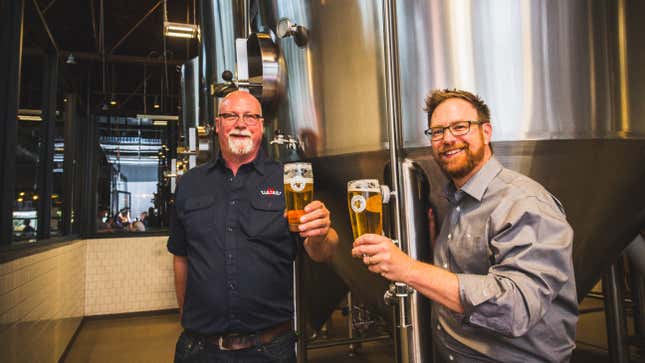
Welcome to Ask Kate About Beer, in which The Takeout’s resident beer expert answers everything you’ve ever wanted to know about beer but were too drunk to ask. Have a question? Shoot it to beer@thetakeout.com.
Hey Kate,
Is a brewery changing the formula of a popular beer a common situation? Basically, I’ve been drinking (and loving) IPAs for years, but I keep running into the same problem—I find a beer I like, drink it religiously for a year or two, when I start to feel like the taste changes. I know there’s some level of familiarity happening, and I’m sure with hoppy beers it might be more intense, but I feel like there’s more to it than that. My tastes in other things don’t seem to change as much—I’m still eating the same food I did in high school and enjoying it!My example is Dale’s Pale Ale. It was my favorite when it was hard to find, but as soon as it got ubiquitous I just didn’t (don’t) like it anymore.
Thanks!
-Mike
Hey Mike,
Thanks for your great question. I reached out to a few brewers—including the Oskar Blues brewer responsible for your beloved Dale’s Pale Ale—to ask how often they change or tweak their recipes. But before we get into why and how often brewers change recipes, let’s also address the psychological aspect of your question.
Yes, breweries change recipes. But our palates also evolve over time as new experiences shift our perceptions. Maybe you once thought a cup of jalapeno-topped chili was spicy—until you tried a ghost pepper. IPAs that tasted boldly citrusy and fruity to customers a decade ago, for example, might seem less vibrant today, given the profusion of more tropical and fragrant hop varieties released for commercial use over the past few years. And that’s to say nothing of the mystique that rarity confers on a beer.
Psychology aside, beer recipes themselves do fluctuate. Remember that beer uses two agricultural products—malted barley and hops—which are variable from year to year, season to season. With changes in weather, those ingredients can be markedly different from one harvest to the next, much to brewers’ chagrin.
“If you by rote followed the exact [beer] recipe every time, and if you had different alpha acids from a different year’s hop crop, you could get more or less bitterness by accident,” Chris Goulet, managing partner of Birdsong Brewery in Charlotte, North Carolina, tells The Takeout. “We will make very small changes every single time we make a beer because we’re adjusting to those variances in the ingredients. The goal of that is so that it tastes as consistent as possible.”
I heard that from every brewer I spoke to: Sometimes, tweaking a recipe is necessary to achieve consistency. It might sound paradoxical, but making small adjustments to account for changes in ingredients actually produces a more uniform product from year to year. Hops especially can vary from one annual harvest to the next, which makes your beloved IPAs tricky. If a brewery uses only one type of hop in an IPA, and that hop’s characteristics change from one year to the next, it could absolutely impact the beer’s flavor.
“Brewmasters can fiddle all they want, but it won’t get you the exact same beer,” says Ron Barchet, co-founder and brewmaster for Victory Brewing in Downington, Pennsylvania. “That’s the unfortunate thing about these hoppy beers, especially those that rely on one hop. That’s why most of our beers, we have a blend of hops that offer similar characteristics so that when that happens, there’s more opportunity to adjust the recipe.”
Tim Matthewss, brewmaster for Oskar Blues in Longmont, Colorado, uses the example of the Centennial hop crop around 2010 and 2011. There was a shortage of Centennial hops at that time—owing to weather and demand—and the available Centennial hops weren’t consistently of the quality the brewery wanted. So Oskar Blues decided to replace Centennial in certain beers with a blend of Cascade and Columbus hops that would create similar flavor and bitterness.
“Raw materials are not consistent, and you have to make adjustments to get those raw materials to coalesce into what you want the vision of that beer to be,” Matthews says. “Over the years you can get closer and closer to your target.”
As technology or ingredients improve, brewers are able to get closer to their goal of what they want a beer to ideally be. Quality-control and analytics equipment have become more sophisticated in recent years; canning technology is much better than it was a decade ago; and brewing chemists are continually making advances in understanding how ingredients like yeast and hops interact.
“If we change something, it’s because we want make [our IPA] Higher Ground more like Higher Ground,” Birdsong’s Goulet says. “We have an idea in our minds of what that beer should be, and if we can make a small change to make that beer more like that, we will.”
So, how much has the recipe for your beloved Oskar Blues Dale’s Pale Ale changed? Very little, says Tim Matthews, who’s been with Oskar Blues since 2008. Not long ago, he sat down with Craig Engelhorn, one of the original Oskar Blues brewers responsible for Dale’s Pale Ale. (Engelhorn has since left Oskar Blues and now owns a distillery.)
“I asked him what he remembered the recipe for Dale’s to be back in 2000,” Matthews recounts. “We wrote our recipes down on separate sheets of paper, didn’t show them to each other. Then we flipped them over, and they were pretty much the same.”
Matthews says any differences in flavor you experienced within the past few years are likely a result of improved canning technology that’s resulted in less oxidation in Dale’s Pale Ale. If you preferred the former version, well, maybe you like a little oxidized flavor in your pale ale.
Aside from tweaks to improve consistency or quality, there’s of course one further reasons breweries might change a recipe: consumer demands. What beer drinkers expect from beers today is not what they expected from beers 15 years ago. Long-standing breweries sometimes switch up aspects of a beloved beer to better meet what customers want out of a particular beer in 2019.

The poster child for this might be Victory Brewing’s Prima Pils, the brewery’s flagship German pilsner first brewed in 1996. Though it’s one of Victory’s most respected beers, the company recently found Prima sales had dropped two years in a row. It was time for a change.
“It’s my child, my favorite beer we make in the brewery so I’m very protective of it,” Barchet says. “But you can’t keep doing the same thing if it’s not working.”
Barchet noticed that he wasn’t able to drink the same quantity of Prima as he used to—by the third beer, his palate felt a little tired. He and the brewing team decided that dropping the beer’s bitterness level ever so slightly—from 5o bitterness units to about 45—might do the trick. Victory’s brewers also changed their process to incorporate Prima’s hops at a different point in the brewing process—almost entirely in the hopback rather than the brew kettle—which gives the beer more hop aroma with less hop bitterness.
“We’re really happy with how it came out. It’s a little more of a modern take based on where taste buds are and where the market is,” Barchet says. “We felt that if Prima was going to carry on, we need to get it a little more modern.”
But there will be no massive announcement of the change, no “New Recipe!” label splashed across six-packs. Victory isn’t trying to hide the change, Barchet says, but they’re also not trying to scare away long-time Prima Pils drinkers. It’s a delicate, calculated risk to take with a venerated beer: in making changes that aim to improve the recipe, there’s a chance some of its steady customers might now like the change. Barchet, for his part, is confident in the new Prima, and he says that as a long-time fan himself.
“I don’t think people will necessarily be able to pick out the change,” he says. “I hope they just think ‘Wow, this is a good batch. This is a Prima batch I really like.’”